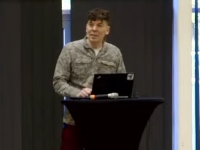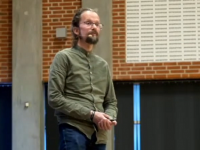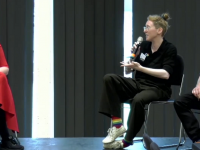It’s a retrospective – from the year 2040! Six speakers tell us what’s happened in their world of larp “in the past 10 years”.
Solmukohta 2020 Futurespective speakers: Erik Winther Paisley, Eleanor Saitta, Eirik Fatland, Johanna Koljonen, Sharon Underberg and Karolina Fedyk.
Transcript
Thanks for the invitation to speak about the state of larp from 2030 through the present. It’s really been an exciting time. Oh, and since it’s not very interesting watching my face as I speak, I’ll share some photos and drawings #of fellow larpers.
I will admit I had my worries. I remember all the talks we had back when the term “older larpers” referred to players in their 40’s and 50’s. Many of us were juggling work and family responsibilities.
We often had more money than the younger larpers, but less time. There were certainly trade offs–
the more experienced players, especially those identifying as male, had a lot of social capital, and were often given leadership roles in larps.
But back then, players identifying as female had a bit harder time–more likely to be typecast as mothers or witches, often defined by their relationships with other players.
And already there was awareness of the physical challenges of aging.
At that time in my life, I thought of the future with some trepidation. As we progressed from “older” to–I don’t know–”old”? Ancient?– a lot of things would change.
I’d anticipated that those of us now in our 60s and 70’s would largely be retired, with more spare time but less spare cash.
What many of us hopefully would have gained in wisdom and experience would be intermixed with losses–of partners, of mobility, of eyesight or hearing, other health challenges.
I had hopes that assistive technology would ameliorate some of the physical challenges, but still–.I was acutely aware.
Even without those losses, the old are often perceived differently by the young. As more frail, more needy, less authoritative, And no longer a peer. Imagine larping with someone like THAT?
But things have turned out way better than I anticipated. One major factor, I think, is that there was a whole cohort of us who were aging at the same time, and many of those people were already pioneers and leaders in the larp community. .
But even those of us who were just players put out the challenge to larp designers. First, give us physical designs that can accommodate our aging bodies, as well as our differently abled younger peers.
A comfortable place to sleep, options for those with physical challenges.
The changes in response to this didn’t happen all at once, nor did they happen universally.
It took time, especially for younger designers and organizers, to really get what we were asking. To do more than pay lip service to the needs of older players.
Some were unwilling or unable to make those changes, sometimes for reasons beyond their control.
There are still ancient castles with winding stairs, still larps centered around physical combat, or running across difficult terrain,
Not all larps are for everyone, but more and more I’ve seen that decision made consciously rather than by inadvertently excluding some players in the design process.
And then there’s the expanding genre of virtual reality larps, where our physical abilities and appearances can morph at will. Talk about empowering….!
But having the physical ability to participate in a larp was only a starting place. Far more important was full inclusion in the story without artificial limits based on age.
This is what we demanded: Design interesting characters for those of us who are older–without the preconceptions and prejudices about what an older player can feel or do.
Give us agency, give us passions and flaws and conflicts. And remember, there is no age limit on either romance or sexuality.
At first it was the older and more experienced designers who responded to this, but once the younger designers saw this modeled, and saw the full breadth of character that someone with six or seven decades of life experience could achieve, many of them followed suit. Not all, but that’s okay.
Because of course, not all larps are for everyone. As there are some designed for younger players, there have been more larps developed specifically for more mature players.
Which only makes sense, because as we have aged, many of us have found ourselves interested in exploring new questions and aspects of larp.
Personally I find myself alternating between escape-from-reality larping and those that explore some of the less comfortable aspects of aging, including memory loss, disability and death.
Let me tell you about my last few larps.
Bjarke Pedersen’s latest larp, The Number of the Beast, featured a satanic cult in which the members are powerless until they reach the age of 66 and 6 months. Taking place at a secluded manor house, the mysterious cult leader hosted a “coming of age” ritual for those finally attaining the ranks of elder. As you can imagine,decadence and madness ensued.
Mythical Fools premiered Navarca, a larp taking place on a generation ship where the inhabitants have lost all knowledge of how to maintain the ship. The lights have been gradually going out, and the larp begins as they are about to be left in total darkness. I played Shim, an elder and hereditary ”Pusher-of-the-keys” who evolved from traditionalist to heretic.
The latest College of Wizardry spinoff, Squaring Seven, takes place in a world where you only gain magic once your seventh child has given birth to their seventh child. During that last pregnancy, the incipient Witchards come together at college to learn about the skills they are about to acquire.. The larp prides itself on being equally accessible as even younger players are allowed to play the students and professors despite the age discrepancy.
Kathy Amende’s latest larp, Retreat, is an intimate parlor larp for 6 characters, in which each character starts with fully fleshed memories, skills and complex relationships with the other players. Through a randomized process, memories and skills are gradually lost, affecting some characters more than others. The powerful evolution of interaction was particularly moving–I’m still processing and dealing with significant bleed..
Meanwhile, Ryan Hart’s latest in his cyberpunk series, Touchstone, uses VR mixed with live action. In a future in which half of humanity has been uploaded to the Cathedral, a giant computer, there are conflicts for rights between the virtual and physical worlds.I greatly enjoyed playing EIGHTBALL, avatar of a powerful Master of Loci who had claimed the Cathedral itself.
On the post apocalyptic front, Chaos League’s Many Mothers was an ecological fable played out in the Sahara Desert. The matriarchal inhabitants of the last oasis are forced to make difficult decisions when their ecosystem is found to be shrinking. Who will stay and who will leave to join the roving motorcycle gangs warring for dominance in the desert?
I was privileged to attend the 20th anniversary rerun of The Rites of Spring, run by an experienced team led by John Shockley. This folk horror larp took place on a remote island off the English coast, where ancient traditions become horrifyingly real both for islanders and visitors. As one of the elders, our roles were central to the plot.
And one more. Avalon Larp Studio’s latest, The Immortal Dilemma, was a thought provoking political larp based on Swift’s Gulliver’s Travels. In the land of Luggnagg, the Struldbrugs are born with a red mark above one eye which indicates they have the blessing–or curse–of living forever, but without the gift of eternal youth. The players are some of the first cohort of struldbruggs, who have been alive and in power long enough that they now own and control everything. Having come to realize that their descendants are suffering under their regime, the Struldbrugs are meeting as a congress to make a consequential decision: either keeping the status quo or giving up all legal rights once they turn 80,remaining powerless for all of their subsequent days. Would removing themselves from society be the solution to give their descendants a chance to have a future of their own? Is it too much of a sacrifice to spend eternity without power or possessions?
So in summary it’s been an amazing ten years of larp, and especially as we age, larp has progressed right with us and given us more and more opportunities. Please, as we come into the future, remember those who are older are the ones who make magic.
This was part of the Solmukohta 2020 online program. https://solmukohta.eu/






